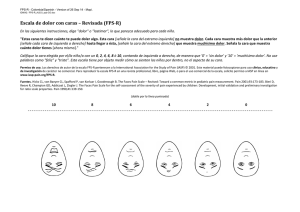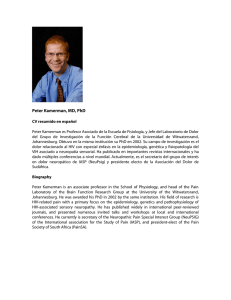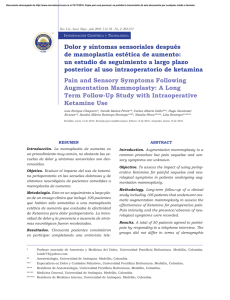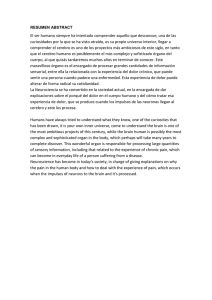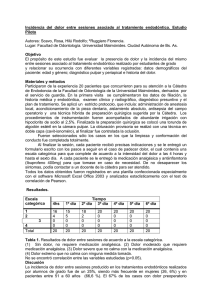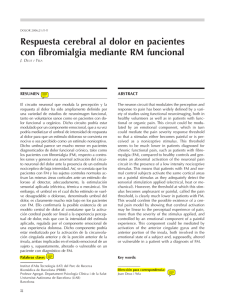Dolor y síntomas sensoriales después de
Anuncio
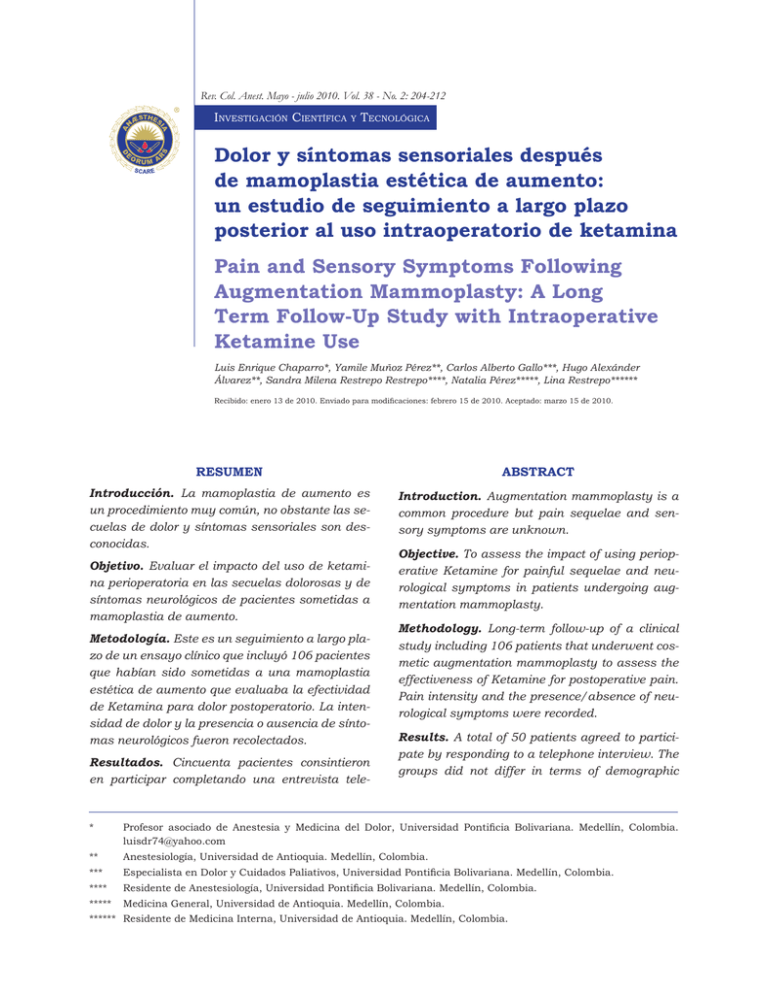
Rev. Col. Anest. Mayo - julio 2010. Vol. 38 - No. 2: 204-212 Investigación Científica y Tecnológica Dolor y síntomas sensoriales después de mamoplastia estética de aumento: un estudio de seguimiento a largo plazo posterior al uso intraoperatorio de ketamina Pain and Sensory Symptoms Following Augmentation Mammoplasty: A Long Term Follow-Up Study with Intraoperative Ketamine Use Luis Enrique Chaparro*, Yamile Muñoz Pérez**, Carlos Alberto Gallo***, Hugo Alexánder Álvarez**, Sandra Milena Restrepo Restrepo****, Natalia Pérez*****, Lina Restrepo****** Recibido: enero 13 de 2010. Enviado para modificaciones: febrero 15 de 2010. Aceptado: marzo 15 de 2010. Resumen Abstract Introducción. La mamoplastia de aumento es un procedimiento muy común, no obstante las secuelas de dolor y síntomas sensoriales son desconocidas. Introduction. Augmentation mammoplasty is a common procedure but pain sequelae and sensory symptoms are unknown. Objetivo. Evaluar el impacto del uso de ketamina perioperatoria en las secuelas dolorosas y de síntomas neurológicos de pacientes sometidas a mamoplastia de aumento. Metodología. Este es un seguimiento a largo plazo de un ensayo clínico que incluyó 106 pacientes que habían sido sometidas a una mamoplastia estética de aumento que evaluaba la efectividad de Ketamina para dolor postoperatorio. La intensidad de dolor y la presencia o ausencia de síntomas neurológicos fueron recolectados. Resultados. Cincuenta pacientes consintieron en participar completando una entrevista tele- Objective. To assess the impact of using perioperative Ketamine for painful sequelae and neurological symptoms in patients undergoing augmentation mammoplasty. Methodology. Long-term follow-up of a clinical study including 106 patients that underwent cosmetic augmentation mammoplasty to assess the effectiveness of Ketamine for postoperative pain. Pain intensity and the presence/absence of neurological symptoms were recorded. Results. A total of 50 patients agreed to participate by responding to a telephone interview. The groups did not differ in terms of demographic * Profesor asociado de Anestesia y Medicina del Dolor, Universidad Pontificia Bolivariana. Medellín, Colombia. [email protected] ** Anestesiología, Universidad de Antioquia. Medellín, Colombia. *** Especialista en Dolor y Cuidados Paliativos, Universidad Pontificia Bolivariana. Medellín, Colombia. **** Residente de Anestesiología, Universidad Pontificia Bolivariana. Medellín, Colombia. ***** Medicina General, Universidad de Antioquia. Medellín, Colombia. ****** Residente de Medicina Interna, Universidad de Antioquia. Medellín, Colombia. Dolor y síntomas sensoriales después de mamoplastia estética de aumento: Un estudio de seguimiento a largo plazo posterior al uso intraoperatorio de ketamina Pain and Sensory Symptoms Following Augmentation Mammoplasty: A Long Term Follow-Up Study with Intraoperative Ketamine Use 205 fónica. Los grupos no difirieron en cuanto a las variables demográficas y la técnica quirúrgica. Ambos grupos reportaron una alta incidencia de dolor moderado a intenso el primer día y la primera semana del postoperatorio (19 y 21 pacientes de los grupos ketamina y placebo respectivamente), con completa resolución de los síntomas a los tres meses. Tres participantes del grupo ketamina reportaron hipoestesia persistente y una participante sensación de ardor. Estos síntomas fueron marginalmente más frecuentes en el grupo placebo con siete participantes que reportaron hipoestesia y dos sensación de ardor. Conclusiones. En este estudio, la ketamina no tuvo un impacto significativo en la incidencia de dolor crónico posterior a mamoplastia estética de aumento. Existe una tendencia a sugerir que la ketamina podría tener algún papel en la reducción de síntomas neurológicos que resultaron ser más frecuentes de lo esperado (20 %). Palabras clave: Estudios de seguimiento, Ketamina, uso terapéutico, mamoplastia, efectos adversos, dolor postoperatorio (Fuente: DeCS, BIREME) Introducción y objetivos En Colombia, la cirugía estética, en especial la mamoplastia de aumento, ha tenido un desarrollo de consideración en los últimos años. Infortunadamente, la incidencia de dolor y síntomas neurológicos persistentes es desconocida. En publicaciones recientes existe una considerable disparidad en cuanto a la real incidencia de este fenómeno (1,2). La etiología del problema divide las opiniones entre los que piensan que es una persistencia de un proceso inflamatorio, una lesión de fibras neurales o, incluso, una combinación de estos (3). Factores como la presencia de dolor intenso agudo postoperatorio, uso perioperatorio de terapias analgésicas multimodales, técnica quirúrgica e incluso factores psicosociales como la ansiedad preoperatoria, podrían ser determinantes en el desarrollo de la entidad (4). En un trabajo publicado previamente por nuestro grupo, se demostró que el uso de ketamina en infusión tiende a disminuir la intensidad de dolor, el consumo de meperidina postoperatoria y una tendencia no significativa a disminuir la variables and the surgical technique. Both groups reported a high incidence of moderate/severe pain on the first day and the week following the operation (19 and 21 patients in the Ketamine and placebo groups, respectively), with complete resolution of symptoms after three months. Three participants in the Ketamine group reported persistent hypoesthesia and one reported a burning sensation. These symptoms were slightly more frequent in the placebo group, with 7 patients reporting hypoesthesia and two burning sensation. Conclusions. In this study, Ketamine had no significant incidence on chronic pain following cosmetic augmentation mammoplasty. There is a trend suggesting that Ketamine could play a role in reducing the neurological symptoms that exceeded the expected frequency (20 %). Keywords: Follow-up studies. Ketamine, therapeutic use, mammoplasty, adverse effects, postoperative pain (Source: MeSH, NLM) Introduction and objectives Cosmetic surgery and augmentation mammoplasty in particular, has experienced a considerable growth in Colombia in the last few years. Unfortunately, the incidence of persistent pain and neurological symptoms is unknown. Recent publications seem to disagree with regards to the incidence of this events (1,2). There are divided opinions with regards to the etiology of the problem. Some believe it is due to persistent inflammation, nerve fiber injury or even a combination thereof (3). Factors such as the presence of intense acute postoperative pain, the use of multimodal perioperative analgesia, the surgical technique and even psychosocial factors, i.e. pre-surgical anxiety, may be determining factors in the development of the condition (4). A paper previously published by our group showed that the use of Ketamine as an infusion tended to reduce both the intensity of pain and the use of post-surgical meperidine, as well as a non-significant trend to reduce the incidence of post-surgical vomiting in patients who under- 206 Rev. Col. Anest. Mayo - julio 2010. Vol. 38 - No. 2: 204-212 incidencia de vómito postoperatorio en pacientes que habían sido sometidas a mamoplastia estética de aumento (5). En este seguimiento a más de un año, se quería evaluar si la ketamina, dadas sus propiedades antihiperalgésicas (6,7), podía influir sobre la persistencia de dolor y síntomas sensitivos en esta cohorte de pacientes. went cosmetic augmentation mammoplasty (5). The intent of this follow-up study extending beyond one year was to assess whether Ketamine could –on account of its antihyperalesic properties (6,7)– have any influence on the persistence of pain and sensory symptoms in this cohort of patients. Materiales y Métodos Materials and Methods Estudio de tipo cohorte, retrospectivo, de seguimiento de un ensayo clínico de asignación aleatoria (5) que obtuvo aprobación del Comité de Ética de la institución universitaria de atención quirúrgica ambulatoria (IPS Universitaria) y del Comité de Educación de la Sección de Anestesia de la Universidad de Antioquia. El seguimiento se llevó a cabo mediante entrevista telefónica o por correo electrónico a las pacientes participantes del ensayo clínico descrito previamente, insistiéndose en el contacto hasta por cinco veces. Previa explicación del objetivo y aceptación de participar del seguimiento, las pacientes respondieron un cuestionario, el cual incluía variables de población, cambio de talla de sostén, técnica quirúrgica y efectos adversos postoperatorios. Las participantes fueron identificadas por código durante el proceso de análisis final de la información y las encuestadoras desconocían si las pacientes habían recibido ketamina o placebo durante el ensayo clínico inicial. A cohort, retrospective, follow-up study of a randomized clinical trial (5) that was approved by the Ethics Committee of the out-patient surgical care university clinic (IPS Universitaria) and by the Education Committee of the Department of Anesthesia of the Antioquia University. The follow-up process was by telephone interview or by e-mail; the patients participating in the clinical trial were asked to make up to five contacts. After explaining the purpose of the trial and upon the acceptance to participate in the follow-up, the patients completed a questionnaire that included population variables, change in the size of their bra, surgical technique and any post-surgical adverse events. The participants were identified by code during the final process of analysis of the information and the interviewers didn’t know if the patient received Ketamine or placebo during the initial clinical trial. Como variables de desenlace se incluyeron el recuerdo de la intensidad del dolor en sala de recuperación y en los intervalos de tiempo (arbitrariamente escogidos por los autores) desde la llegada a casa hasta la primera semana (fase aguda), desde la primera semana del postoperatorio hasta los tres primeros meses (fase subaguda) y desde los tres meses hasta el momento de la realización de la encuesta (fase crónica). Para mantener la significancia clínica y dado que es un reporte retrospectivo, la intensidad de dolor se valoró, no con una escala numérica como es usual, sino con una escala categórica (no dolor, dolor leve, moderado o intenso). Finalmente se tomó como clínicamente significativo el reporte de dolor moderado o intenso. Como variables secundarias se preguntó sobre el desarrollo de síntomas tipo dolor neuropático (ardor, quemazón, hipoestesia y disestesia) en los mismos periodos. Para evitar The outcome variables included memories of pain severity in the recovery room and at various time intervals (selected arbitrarily by the authors) from the moment they returned home and up to the first week after surgery (subacute phase) and then from three months and up to the time of the survey (chronic phase). In order to preserve the clinical significance –considering that this was a retrospective report– the pain intensity was not assessed with a numerical scale as is usually the case, but with a categorical scale (no pain, mild, moderate or severe pain). Finally, a report of moderate or intense pain was considered clinically significant. The secondary variables included questions about the development of symptoms such as neuropathic pain (stabbing pain, burning sensation, hypoesthesia and dysesthesia) during the same periods of time. To avoid any Dolor y síntomas sensoriales después de mamoplastia estética de aumento: Un estudio de seguimiento a largo plazo posterior al uso intraoperatorio de ketamina Pain and Sensory Symptoms Following Augmentation Mammoplasty: A Long Term Follow-Up Study with Intraoperative Ketamine Use 207 sesgos de información, la encuesta fue realizada por mujeres profesionales de la salud. biases in the information, female health professionals administered the survey. Análisis Estadístico Statistical Analysis Se creó una base de datos en el programa Excel (Microsoft Corp. Microsoft Office Version 972000). En el análisis demográfico, se utilizaron medidas de resumen tipo media o mediana, de acuerdo con la distribución de las variables y medidas de dispersión como desviación estándar. Para evaluar la asociación entre variables cualitativas, se utilizó la prueba de ji al cuadrado incluyendo la prueba de McNemar y en las variables cuantitativas se utilizó la prueba de T de Student. En los casos en que se utilizó análisis multivariado, la prueba fue la regresión logística se tuvieron en cuenta factores como el tipo de incisión, el tiempo de seguimiento, la edad y la ubicación de la prótesis. Se utilizó Cytel Studio 8.0 (Cytel Corp. Massachusetts, Estados Unidos) como paquete estadístico. Se tomó como punto de corte de significancia estadística una p menor de 0,05. Resultados Del grupo inicial del estudio, se obtuvo información de 25 pacientes que habían recibido ketamina y de 25 que habían recibido placebo (figura 1). Las variables de población fueron similares (tabla 1). El promedio de seguimiento fue de 18,9 meses (desviación estándar (DE = 1,96) y 19,03 meses (DE = 1,98) respectivamente. Con respecto al recuerdo del periodo agudo postoperatorio (tabla 2), las participantes reportaron una alta incidencia de dolor y síntomas de tipo neuropático. Hubo una menor incidencia de estos síntomas (sensación de ardor, quemazón e hipoestesia) en el grupo de pacientes que recibieron ketamina aunque la diferencia no fue estadísticamente significativa. Durante la fase subaguda, no se encontraron diferencias. En la fase crónica, no se reportaron casos de dolor moderado o intenso, pero en tres pacientes, dos del grupo placebo y una del grupo ketamina, persistía la sensación de ardor. La sensación de hipoestesia persistía en tres pacientes (12 %) en el grupo de ketamina versus siete pacientes (28 %) en el grupo control (p = 0,17; RR 0,43 [IC 95 %: 0,12 - 1,47]). An Excel (Microsoft Corp. Microsoft Office Version 97-2000) database was developed. The demographic analysis used mean or average measurements, in accordance with the distribution of variables and measures of dispersion such as the standard deviation. To assess the relationship among qualitative variables, the chi-square test was used, including McNemar’s test and the Student’s-T test for the quantitative variables. The logistical regression test was administered in those cases where a multivariate analysis was used, considering factors such as the type of incision, type of follow-up, age and placement of the implant. The statistical package used was Cytel Studio 8.0 (Cytel Corp. Massachusetts, USA). The cut point for statistical significance was p < 0,05. Results Of the initial study group, information was obtained from 25 patients that received Ketamine and 25 patients receiving placebo ���� (figure 1). The demographic variables were similar (table 1). The average follow-up was 18.9 months (SD = 1.96) and 19.03 months (SD = 1.98) respectively. With regards to the memories of acute postoperative pain (table 2), the participants reported a high incidence of pain and neuropathic symptoms. There was a lower incidence of these symptoms (burning sensation and hypoesthesia) among the group of patients that received Ketamine, although the difference was not statistically significant. No differences were found during the sub-acute phase. There were no reports of moderate or severe pain during the chronic phase; however, three patients, two from the placebo group and one from the Ketamine group, had persistent burning sensation. Hypoesthesia persisted in three patients (12 %) in the Ketamine group versus seven (28 %) patients in the control group (p = 0.17; RR 0.43 [IC 95 %: 0.12 - 1.47]). 208 Rev. Col. Anest. Mayo - julio 2010. Vol. 38 - No. 2: 204-212 Figura 1. Flujograma de pacientes estudiados Figure 1. Flowchart of Patients Studied Pacientes Estudio inicial Patients Inicial Study n = 106 n = 106 Pacientes excluidas Patients Excluded n = 56 • 47 Residentes en el exterior • 2 Teléfono equivocado • 7 Cambio de domicilio n = 56 • 47 Residents in other countries • 2 Wrong telephone number • 7 Change of domicile Pacientes incluidas Patients Included n = 50 n = 50 Grupo Ketamina n = 25 Ketamine Group n = 25 Grupo Placebo n = 25 Tabla 1. Variables poblacionales Table 1. Demographic Variables Ketamina Placebo Valor de Pb Edad en años (DE)a 30,1 (6,1) 28,1 (6,4) n.s. Peso (kg) 55,9 (6,3) 52,6 (4,6) n.s. Talla del sostén Previo a la cirugía Posterior a la cirugía Subglandular Submamaria a b Placebo P bValue Age – years (SD)a 30.1 (6.1) 28.1 (6.4) n.s. Body weight (kg) 55.9 (6.3) 52.6 (4.6) n.s. 31.8 (1.5) 31.9 (1.2) n.s. 35 (1.2) 34.9 (1.2) n.s. 23/25 22/25 n.s. 2/25 3/25 n.s. 23/25 24/25 2/25 1/25 31,8 (1,5) 31,9 (1,2) n.s. Before surgery 35 (1,2) 34,9 (1,2) n.s. Post-surgery Placement of implant 23/25 22/25 n.s. Retro-muscular 2/25 3/25 n.s. Sub-glandular Surgical Incision Incisión quirúrgica Periareolar Ketamine Size of Bra Localización de la prótesis Retromuscular Placebo Group n = 25 23/25 24/25 2/25 1/25 Desviación estándar No significativo: p > 0,05 Periareolar n.s. Sub-mammary a b Standard deviation Non significant: p > 0.05 n.s. Dolor y síntomas sensoriales después de mamoplastia estética de aumento: Un estudio de seguimiento a largo plazo posterior al uso intraoperatorio de ketamina Pain and Sensory Symptoms Following Augmentation Mammoplasty: A Long Term Follow-Up Study with Intraoperative Ketamine Use 209 Tabla 2. Incidencia global de memoria de eventos de primera semana del postoperatorio a Ketamina Placebo ORa ICb 95 % Pc Dolor moderado-severo en sala de recuperación (%) 15/25 (60) 21/25 (84) 0,28 0,07-1,08 n.s. Dolor moderado-severo en casa (%) 19/25 (76) 21/25 (84) 0,60 0,15-2,5 n.s. Limitación para actividades del hogar (%) 15/25 (60) 16/25 (64) 0,84 0,27-2,65 n.s. Náusea en casa (%) 10/25 (40) 8/25 (32) 1,41 0,44-4,5 n.s. Vómito en casa (%) 5/25 (20) 5/25 (20) 1,00 0,25-4,0 n.s. Dolor significativo en la incisión quirúrgica (%) 6/25 (24) 12/25 (48) 0,34 0,10-1,1 n.s. Sensación de ardor (%) 4/25 (16) 8/25 (32) 0,40 0,10-1,5 n.s. Sensación de quemadura (%) 3/25 (12) 4/25 (16) 0,71 0,14-3,5 n.s. Hipoestesias (%) 10/25 (40) 15/25 (60) 0,44 0,14-1,4 n.s. Disestesia (%) 13/25 (52) 13/25 (52) 1,00 0,3-3,3 n.s. Odds ratio: riesgo relativo indirecto. b Intervalo de confianza. c Valor de p. n.s.: no significativo = p > 0,05 Table 2. Global Incidence of Event Memories During the First Postoperative Week Ketamine Placebo ORa ICb 95 % Pc Moderate to severe pain the recovery room (%) 15/25 (60) 21/25 (84) 0.28 0.07-1.08 n.s. Moderate to severe pain at home (%) 19/25 (76) 21/25 (84) 0.60 0.15-2.5 n.s. Limitation to do household chores (%) 15/25 (60) 16/25 (64) 0.84 0.27-2.65 n.s. Nausea at home (%) 10/25 (40) 8/25 (32) 1.41 0.44-4.5 n.s. Vomiting at home (%) 5/25 (20) 5/25 (20) 1.00 0.25-4.0 n.s. Significant surgical incision pain (%) 6/25 (24) 12/25 (48) 0.34 0.10-1.1 n.s. Stabbing pain (%) 4/25 (16) 8/25 (32) 0.40 0.10-1.5 n.s. Burning sensation (%) 3/25 (12) 4/25 (16) 0.71 0.14-3.5 n.s. Hypoesthesia (%) 10/25 (40) 15/25 (60) 0.44 0.14-1.4 n.s. Dysesthesia (%) 13/25 (52) 13/25 (52) 1.00 0.3-3.3 n.s. a Odds Ratio: relative indirect risk. b Confidence Interval. c P-Value. n.s.: non significant = p > 0.05 Discusión Discussion El papel de la ketamina en la disminución de la incidencia de dolor crónico es desconocido, debido a la falta de estudios de asignación al azar con seguimiento a largo plazo (8), aunque existen estudios prospectivos en curso que sustentan la significancia clínica de nuestro trabajo (clinicaltrials.gov Identifier: NCT00618423). Se The role of Ketamine in reducing the incidence of chronic pain is unknown due to a lack of randomized, long-term follow-up studies (8), although there are some on-going prospective studies supporting the clinical significance of our work (clinicaltrials.gov Identifier: NCT00618423). It was shown that Ketamine 210 Rev. Col. Anest. Mayo - julio 2010. Vol. 38 - No. 2: 204-212 comprobó una tendencia protectora de la ketamina para disminuir los síntomas dolorosos y neuropáticos en el periodo postoperatorio que no alcanzaron significancia estadística, debido principalmente al tamaño de muestra recolectado. Aunque observamos una significativa incidencia de síntomas neurológicos, tales como sensación de ardor, quemazón e hipoestesia, que generalmente se resolvieron durante la primera semana del postoperatorio, encontramos persistencia de hipoestesia en el área quirúrgica en 20 % y de ardor quemazón en el 6 % del total de los casos. La interpretación de estos hallazgos queda a juicio individual de los clínicos. Es importante resaltar que la literatura, en revistas de cirugía plástica, reporta incidencias de hipoestesia entre 4 % y 11% (1), pero estudios más recientes del mismo modelo quirúrgico informan incidencias de anormalidades sensoriales entre el 30 % y 56 % de los casos (2); el mismo estudio reporta una incidencia de dolor evocado alrededor del 13 % a un año de seguimiento. Nuestro interés en realizar el seguimiento partió de la presunción neurofisiológica de que, en el caso del dolor intenso agudo –como ocurrió en el ensayo original– debería existir una mayor posibilidad de persistencia de dolor postoperatorio (9) y, más aún, en una zona tan inervada como la mama. Además, sentíamos curiosidad por la incidencia del suceso en un procedimiento tan promovido en nuestro medio. La incidencia de dolor crónico postoperatorio tiende a asociarse a la persistencia de síntomas neuropáticos como ardor, quemazón e hipoestesia; sorprendentemen­ te, nuestras pacientes negaron persistencia del dolor, lo cual podría obedecer a un sesgo de selección que llevaría a colaborar más factiblemente con la encuesta a las pacientes que se sentían más satisfechas del resultado y a factores psicosociales relacionados con el procedimiento (10). Mucho se ha discutido sobre el papel de la técnica quirúrgica como un factor que predispone al desarrollo de dolor crónico en otros modelos quirúrgicos, como la herniorrafia inguinal, en la cual la incidencia del hecho tiende a estar alrededor del 10 % (11). En la mamoplastia de aumento, el abordaje retromuscular reviste mayor posibilidad de manipulación del paquete vascular-nervioso, has a protective effect by reducing the painful and neuropathic symptoms during the postoperative period but did not reach statistical significance mainly because of the small sample size. Though we observed a significant incidence of neurological symptoms, such as pain, burning sensation and hypoesthesia those usually resolved during the first post-surgical week; however, there was a 20 % persistence of hypoesthesia of the surgical area and 6 % persistence of burning sensation out of the total number of cases. Each clinician shall then individually interpret these findings. It is important to stress that the literature in plastic surgery journals, reports incidences of hypoesthesia from 4 % to 11% (1), but recent studies on the same surgical model report incidences of sensory abnormalities between 30 % and 56 % of the cases (2). The same study reports an incidence of evoked pain of around 13 % in one year of follow-up. Our interest in doing the follow-up was based on the neuro-physiological presumption that in the case of acute severe pain –as was the case in the original trial– there had to be a higher probability of postoperative pain persistence (9), even more so in a very innervated area such as the breast. Furthermore, we were curious about the incidence of the event in a procedure that is so strongly encouraged in our environment. The incidence of chronic postoperative pain tends to be related to the persistence of neuropathic symptoms such as burning sensation and hypoesthesia; surprisingly enough, our patients denied the persistence of pain, but this could be due to the selection bias that urged the patients who were more pleased with the results to be more willing to cooperate with the survey and to psychosocial factors related to the procedure (10). A lot has been said about the role of the surgical technique as a predisposing factor for the development of chronic pain in other surgical models like the inguinal herniorrhaphy, where the incidence of chronic pain is around 10 % (11). In augmentation mammoplasty, the retromuscular approach enhances the possibility of nerve bundle manipulation, increasing the probability of inducing persistent postoperative Dolor y síntomas sensoriales después de mamoplastia estética de aumento: Un estudio de seguimiento a largo plazo posterior al uso intraoperatorio de ketamina Pain and Sensory Symptoms Following Augmentation Mammoplasty: A Long Term Follow-Up Study with Intraoperative Ketamine Use 211 y por ende, más probabilidad de inducir dolor persistente postoperatorio (2,12). Las incisiones periareolares parecen favorecer el desarrollo de dolor intenso (13). Es de resaltar que en el ensayo clínico original el cirujano plástico no practicó infiltraciones con anestésico local y, también, que en la inmensa mayoría de nuestras pacientes se usó la técnica retromuscular, por lo cual no es posible deducir de nuestro estudio la importancia de estos factores. La única intervención que ha demostrado disminuir la incidencia a largo plazo de cambios sensoriales (hipoestesia e hiperestesia), sin un efecto importante en la incidencia de dolor posterior a mamoplastia de aumento, es el uso de 125 mg de metilprednisolona (2). En nuestra institución, tenemos protocolizado el uso sistemático de dexametasona a dosis de 4 mg para la prevención de náuseas y vómito postoperatorios, aunque recientemente se sugiere aumentar la dosis a 8 mg para agregar un efecto analgésico (14-16). Son múltiples las dificultades que se presentan al realizar estudios de seguimiento. En nuestro estudio, la mayoría de las pacientes venían del exterior a realizarse la cirugía y el cambio de domicilio fue otro factor importante, al igual que el suministro erróneo de información (telefónica) y la reserva de la intimidad de las pacientes que no quisieron aportar los datos. En conclusión, las alteraciones sensoriales posteriores a mamoplastia de aumento son un problema real y significativo que la gran mayoría de las veces tiende a resolverse entre la primera semana y los tres primeros meses del postoperatorio. Sin embargo, la persistencia de hipoestesia es un hecho por discutir con las pacientes que desean la cirugía. Se requieren más estudios para definir el papel protector de la ketamina. Agradecimientos Queremos agradecer a las participantes del es­­tudio, quienes de forma desinteresada nos aportaron su experiencia, a la Unidad de Cirugía Ambulatoria de la IPS de la Universidad de Antioquia y al Dr. Flavio Bohórquez, estimado cirujano plástico y amigo. Finalmente, agradecemos muy especialmente al Dr. Fernando Montoya por colaborarnos desinteresadamente con el análisis estadístico. pain (2,12). The periareolar incision seems to promote the development of severe pain (13). It should be emphasized that in the original clinical study, the plastic surgeon did not administer any local anesthetic infiltrations, and in most of our patients, the technique used was the retromuscular approach; hence it is impossible to determine the importance of these factors in our study. The only intervention that has proven to show long term incidence of sensory changes (hypoesthesia and hyperesthesia), with no relevant incidence of pain following augmentation mammoplasty is the use of 125 mg of methylprednisolone (2). The systematic use of 4 mg dexametasone for the prevention of post-surgical nausea and vomiting has been standardized at our institution, though a dose increase to 8 mg has been recently suggested for added analgesia (14-16). Follow-up studies pose a myriad of obstacles. In our study, most patients came from abroad to undergo their surgeries; other important factors were change of domicile, wrong telephone numbers and the fact that patients wanted to preserve their intimacy. In conclusion, sensory disorders following augmentation mammoplasty are a real and significant concern that mostly tends to resolve between the first week and the first three months after surgery. However, persistent hypoesthesia is a fact and it should be discussed with patients who want to undergo surgery. Additional studies are required to determine the protective role of Ketamine. Acknowledgements We want to express our gratitude to the participants in the study for their generous contribution in sharing their experience; to the outpatient surgical unit of the University of Antioquia, and to Dr. Flavio Bohórquez, plastic surgeon and dear friend. Finally, we would like to thank Dr. Fernando Montoya for his generous support with the statistical analysis. 212 Rev. Col. Anest. Mayo - julio 2010. Vol. 38 - No. 2: 204-212 REFERENCES 1. Stoff-Khalili MA, Scholze R, Morgan WR, Metcalf JD. Subfascial periareolar augmentation mammaplasty. Plast Reconstr Surg. 2004;114(5):1280-8; discussion 1289-91. 2. Romundstad L, Breivik H, Roald H, Skolleborg K, Romundstad PR, Stubhaug A. Chronic pain and sensory changes after augmentation mammoplasty: long term effects of preincisional administration of methylprednisolone. Pain. 2006;124(1-2):92-9. 3. Wilder-Smith OH, Arendt-Nielsen L. Postoperative hyperalgesia: its clinical importance and relevance. Anesthesiology. 2006;104(3):601-7. 4. Macrae WA. Chronic post-surgical pain: 10 years on. Br J Anaesth. 2008;101(1):77-86. 5. Chaparro LE, Giraldo N, Pabón LF, Agudelo S, Castillo JM, Gómez I. Efectividad de la ketamina para reducir los requerimientos perioperatorios de opioides. Rev Col Anest. 2005;33(3):169-74. 6. De Kock MF, Lavand'homme PM. The clinical role of NMDA receptor antagonists for the treatment of postoperative pain. Best Pract Res Clin Anaesthesiol. 2007;21(1):85-98. 7. Woolf CJ. Central sensitization: uncovering the relation between pain and plasticity. Anesthesiology. 2007;106(4):864-7. 8. Bell RF, Dahl JB, Moore RA, Kalso E. Perioperative ketamine for acute postoperative pain. Cochrane Database Syst Rev. 2006(1):CD004603. Conflicto de intereses: ninguno declarado. 9. Poleshuck EL, Katz J, Andrus CH, Hogan LA, Jung BF, Kulick DI, et al. Risk factors for chronic pain following breast cancer surgery: a prospective study. J Pain. 2006;7(9):626-34. 10. Kehlet H, Jensen TS, Woolf CJ. Persistent postsurgical pain: risk factors and prevention. Lancet. 2006;367(9522):1618-25. 11. Nienhuijs S, Staal E, Strobbe L, Rosman C, Groenewoud H, Bleichrodt R. Chronic pain after mesh repair of inguinal hernia: a systematic review. Am J Surg. 2007;194(3):394-400. 12. Tebbetts JB. Achieving a predictable 24-hour return to normal activities after breast augmentation: part I. Refining practices by using motion and time study principles. Plast Reconstr Surg. 2002;109(1):273-90; discussion 91-2. 13. Gryskiewicz JM. Avoiding pain and suffering after breast augmentation. Plast Reconstr Surg. 2002;110(7):1812-3. 14. Fukami Y, Terasaki M, Okamoto Y, Sakaguchi K, Murata T, Ohkubo M, et al. Efficacy of preoperative dexamethasone in patients with laparoscopic cholecystectomy: a prospective randomized double-blind study. J Hepatobiliary Pancreat Surg. 2009;16(3):367-71. 15. Jokela RM, Ahonen JV, Tallgren MK, Marjakangas PC, Korttila KT. The effective analgesic dose of dexamethasone after laparoscopic hysterectomy. Anesth Analg. 2009;109(2):607-15. 16. Koc S, Memis D, Sut N. The preoperative use of gabapentin, dexamethasone, and their combination in varicocele surgery: a randomized controlled trial. Anesth Analg. 2007;105(4):1137-42, table of contents.
